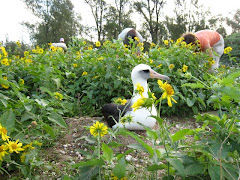





Day 2- Albatross Module by R. Brennon
Can’t believe its Wednesday already! We’ve been on Midway now for two whole days. It’s my job to blog about our adventures this morning.
We were very fortunate to have John Klavitter, of FWS, talk to us about the albatross (or moli). He’s extremely knowledgeable, and he’s also extremely approachable – a wonderful combination. John has years of experience with the albatross and he happily answered all of our questions. It was good planning to meet with John on our second day on island, in that it gave us a deeper understanding of these amazing creatures we’re all conscientiously weaving around all day (everyone moves for the albatross – the golf carts, the bikes, the walkers –everyone). We learned a bunch of things from his talk. There’s too much to put into a blog, but here's just a couple of the facts that I thought were interesting:
There are 1.5 million albatross on Midway
There’s a chemical in the albatross’s eyes that gives them the ability to see at night
There are four common threads between the courting dances of different species of albatross: spreading wings, standing up on tippy toes, making some sort of call, and clacking their bills
Albatross chicks don’t produce their first bolus until they are about 4 months old…so that means that they collect a LOT of plastic in their gut through feeding
We've been learning about the albatross on our own, as well. We can't help but observe them as we move around the island. They are scattered everywhere, chicks sitting within a beaks reach, juveniles strutting about looking for love, hard working adults landing like jet planes in the middle of a block party. Juveniles erupt in spontaneous dances in groups of two or three or four. An earthen sea of endless somber chicks stretches to the horizon. The chicks look as if they've started getting dressed up in feather boas and wacky wigs, but quit halfway through their preparations. It would be impossible to go anywhere on the island and not look at the albatross.
They are amazingly big birds. Here's a picture to give some sense of scale...and remember, this is a fledgling, not an adult. The chicks sit back on their haunches, raising their feet up like they're lounging in reclining chairs no one else can see. They sit and patiently wait for their parents to bring their next meal. The adults move both through the air and on the ground. They are ungainly on land, waddling around on their big spatulas of feet, but once they hit the air they soar. Sometimes the chicks and adults seem to cuddle, sitting close to each other and touching each other gently.
All day long and into the night, the albatross make me laugh...not at them, but with joy. Their beauty and grace and clumsiness and goofy looks and lack of fear and novel voice all combine to create a creature impossible to ignore. They deserve our respect, and they deserve our efforts to stop impacting them negatively. One small choice by each person who reads this to change their habits in using and buying plastic can make a difference. It WILL make a difference. My choice is never to buy another plastic lighter. I've seen too many here on this island, and I know the path those lighters took to get here.



















